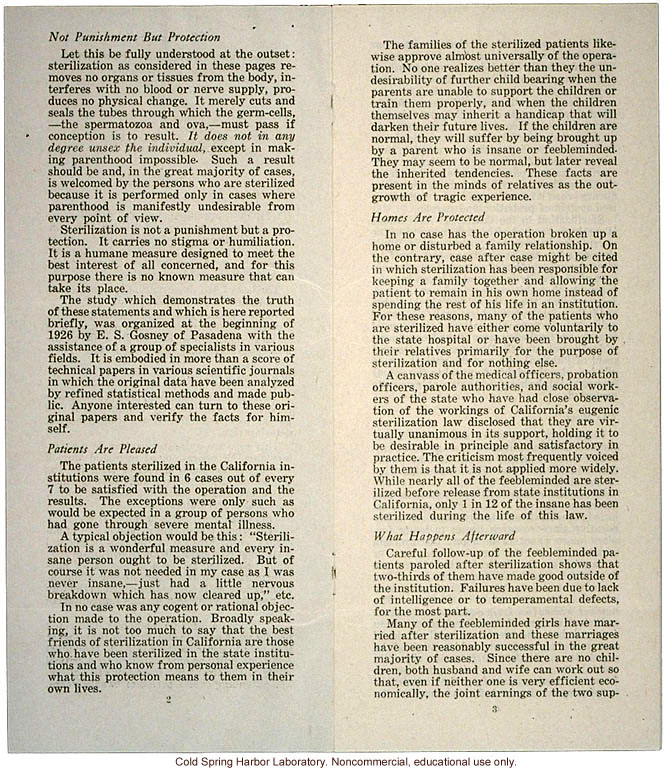[left side]
Not Punishment But Protection
Let this be fully understood at the outset: sterilization as considered in these pages removes no organs or tissues from the body, interferes with no blood or nerve supply, produces no physical change. It merely cuts and seals the tubes through which the germ-cells, --the spermatozoa and ova, -- must pass if conception is to result. [italics]It does not in any degree unsex the individual,[end italics] except in making parenthood impossible. Such a result should be and, in the great majority of cases, is welcomed by the persons who are sterilized because it is performed only in cases where parenthood is manifestly undesirable from every point of view.
Sterilization is not a punishment but a protection. It carries no stigma or humiliation. It is a humane measure designed to meet the best interest of all concerned, and for this purpose there is no known measure that can take its place.
The study which demonstrates the truth of these statements and which is here reported briefly, was organized at the beginning of 1926 by E. S. Gosney of Pasadena with the assistance of a group of specialists in various fields. It is embodied in more than a score of technical papers in various scientific journals in which the original data have been analyzed by refined statistical methods and made public. Anyone interested can turn to these original papers and verify the facts for himself.
Patients Are Pleased
The patients sterilized in California institutions were found in 6 cases out of every 7 to be satisfied with the operation and the results. The exceptions were only such as would be expected in a group of persons who had gone through severe mental illness.
A typical objection would be this: "Sterilization is a wonderful measure and every insane person ought to be sterilized. But of course it was not needed in my case as I was never insane, -- just had a little nervous breakdown which has now cleared up," etc.
In no case was any cogent or rational objection made to the operation. Broadly speaking, it is not too much to say that the best friends of sterilization in California are those who have been sterilized in the state institutions and who know from personal experience what this protection means to them in their own lives.
2
[right side]
The families of the sterilized likewise approve almost universally of the operation. No one realizes better than they the undesirability of further child bearing when the parents are unable to support the children or train them properly, and when the children themselves may inherit the handicap that will darken their future lives. If the children are normal, they will suffer by being brought up by a parent who is insane or feebleminded. They may seem to be normal, but later reveal the inherited tendencies. These facts are present in the minds of relatives as the outgrowth of tragic experience.
Homes Are Protected
In no case has the operation broken up a home or disturbed a family relationship. On the contrary, case after case might be cited in which sterilization has been responsible for keeping a family together and allowing the patient to remain in his own home instead of spending the rest of his life in an institution. For these reasons, many of the patients who are sterilized have either come voluntarily to the state hospital or have been brought by their relatives primarily for the purpose of sterilization and for nothing else.
A canvass of the medical officers, probation officers, parole authorities, and social workers of the state who have had close observation of the workings of California's eugenic sterilization law disclosed that they are virtually unanimous in its support, holding it to be desirable in principle and satisfactory in practice. The criticism most frequently voiced by then is that it is not applied more widely. While nearly all of the feebleminded are sterilized before release from state institutions in California, only 1 in 12 of the insane has been sterilized during the life of this law.
What Happens Afterward
Careful follow-up of the feebleminded patients paroled after sterilization shows that two-thirds of them have made good outside of the institution. Failures have been due to lack of intelligence or to temperamental defects, for the most part.
Many of the feebleminded girls have married after sterilization and these marriages have been reasonably successful in the great majority of cases. Since there are no children, both husband and wife can work out so that, even if neither one is very efficient economically, the joint earnings of the two sup-
3
[end]


